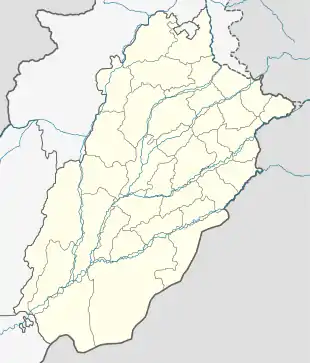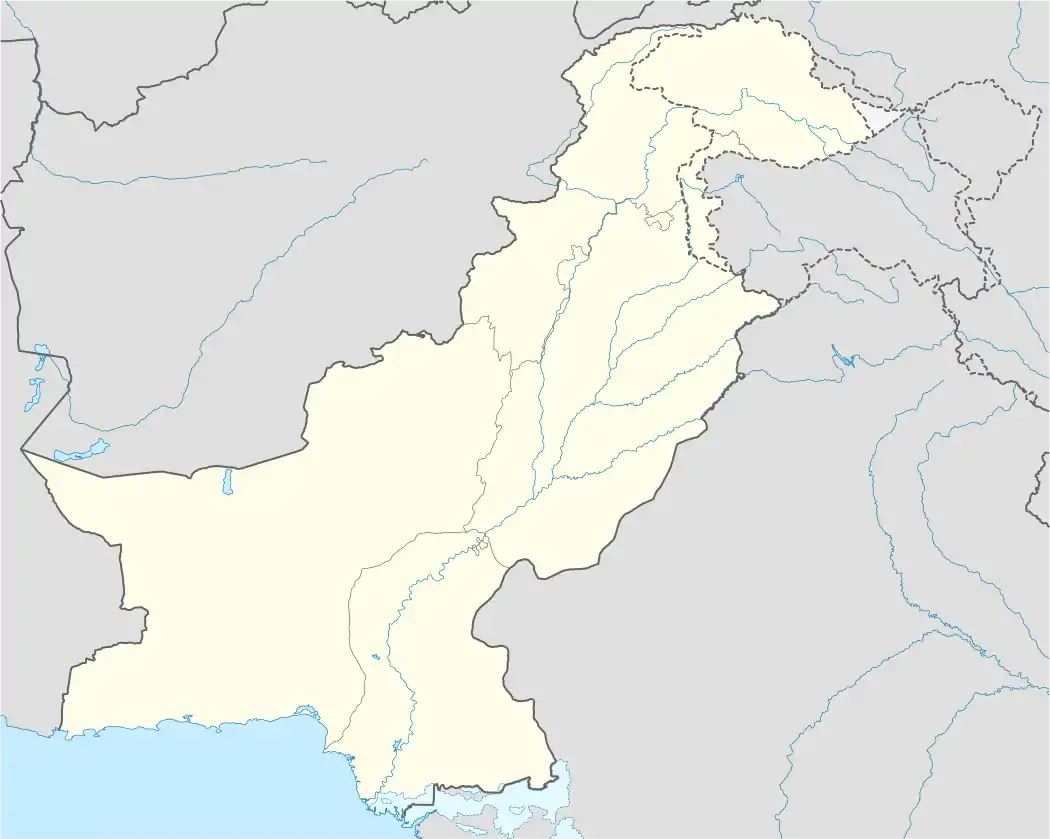Battle of Chawinda
The Battle of Chawinda was a major engagement between Pakistan and India in the Second Kashmir War[note 2] as part of the Sialkot Campaign. It is well-known as being one of the largest tank battles in history since the Battle of Kursk, which was fought between the Soviet Union and Nazi Germany in World War II.[16]
| Battle of Chawinda | |||||||||
|---|---|---|---|---|---|---|---|---|---|
| Part of the Indo-Pakistani War of 1965 | |||||||||
| |||||||||
| Belligerents | |||||||||
|
|
| ||||||||
| Commanders and leaders | |||||||||
Later:
|
| ||||||||
| Units involved | |||||||||
|
| ||||||||
| Strength | |||||||||
|
| ||||||||
| Casualties and losses | |||||||||
 Chawinda Location of Chawinda in Pakistani Punjab | |||||||||
The initial clashes in Chawinda coincided with the Battle of Phillora, and the fighting here intensified once the Pakistani forces at Phillora retreated. The battle came to an end shortly before the United Nations Security Council mandated an immediate ceasefire, which would formally end the hostilities of the 1965 war.[17][18]
Military formations
The commander of the Indian Army's I Corps, Lieutenant General Pat Dunn, was given an assortment of units; 1st Armoured Division, 6th Mountain Division, 14th Division and 26th Division. The Pakistani force expected to oppose the Indian thrust consisted of 15th Division, 6th Armoured Division and 4th Artillery Corps. Later reinforcements included the 8th Infantry Division and 1st Armoured Division.
The battle
The aim of the assault was to seize the Grand Trunk Road around Wazirabad and to capture Jassoran, which would enable control of the Sialkot-Pasrur railway, thus completely cutting off vital Pakistani supply lines.[19] The main striking force of the Indian I Corps was the 1st Armoured Division, which was supported by the 14th Infantry and 6th Mountain divisions. Indian forces seized the border area on 7 September 1965. This was followed by a short engagement at Jassoran in which the Pakistanis suffered losses in the form of about 10 tanks, consequently ensuring complete Indian dominance over the Sialkot-Pasrur railway.[19]
Realizing the severe threat posed by the Indians in Sialkot, the Pakistanis rushed two regiments of the 6th Armoured Division from Chamb, Indian-administered Jammu and Kashmir (located today in Pakistani-administered Azad Jammu and Kashmir) to the Sialkot sector to support the Pakistani 7th Infantry Division fighting there. These units, supported by an independent tank destroyer squadron, amounted to about 135 tanks; 24 M47 and M48 Pattons, about 15 M36B1s and the rest Shermans. The majority of the American Pattons belonged to the new 25th Cavalry under the command of Lieutenant Colonel Nisar Ahmed Khan, which was sent to Chawinda. Intense fighting around the village of Gadgor between the Indian 1st Armoured Division and the Pakistani 25th Cavalry Regiment resulted in the Indian advance being stopped.
The Indian plan was to drive a wedge between Sialkot and the Pakistani 6th Armoured Division. At the time, only one Pakistani regiment was present in the area, and it was wiped out by the Indian 1st Armoured Division's thrust, spearheaded by the 43rd Lorried Infantry Brigade and a tank regiment attacking Gat. The bulk of the Indian 1st Armoured Brigade was hurled towards Phillora. Pakistani air attacks caused significant damage to the Indian tank columns and exacted a heavy toll on the truck columns and infantry. The terrain of the area was very different from that of the area surrounding Lahore, being quite dusty, and therefore the Indian offensive's advance was evident to the Pakistani 25th Cavalry by the rising dust columns on the Charwah-Phillora road.
Indian forces resumed their offensive on 10 September 1965 with multiple corps-sized assaults and succeeded in pushing the Pakistani forces back to their base at Chawinda, where the Indian advance was eventually stopped. A Pakistani counterattack at Phillora was repulsed with heavy losses, after which the Pakistanis took up defensive positions. The situation for the Pakistanis at this point was highly perilous; the Indians outnumbered them ten to one.
However, the Pakistani situation improved as reinforcements arrived, consisting of two independent brigades from Kashmir: the 8th Infantry Division, and more crucially, the 1st Armoured Division. For the next several days, Pakistani forces repulsed Indian attacks on Chawinda. A major Indian assault involving India's 1st Armoured and 6th Mountain divisions on 18 September was repelled, with the Indians suffering heavy losses. Following this, on 21 September, the Indians withdrew to a defensive position near their original bridgehead, with the retreat of India's advancing divisions, all the offensives were effectively halted on that front.[20]
Pakistani officers vetoed the proposed counterattack, dubbed "Operation Windup", in light of the Indians' retreat. According to the Pakistani commander-in-chief, the operation was cancelled due to the fact that "both sides had suffered heavy tank losses...... would have been of no strategic importance...." and, above all: "the decision... was politically motivated as by then the Government of Pakistan had made up their mind to accept [the] ceasefire and foreign-sponsored proposals".[10]
Outcome
The battle has widely been described as one of the largest tank battles since World War II.[21] On 22 September 1965, the United Nations Security Council unanimously passed a resolution that called for an immediate and unconditional ceasefire from both nations.[17][22] The war ended the following day. The international military and economic assistance to both countries had stopped when the war started. Pakistan had suffered attrition to its military might and serious reverses in the Battle of Asal Uttar and Chawinda, which made way for its acceptance of the United Nations ceasefire.[5]
Following the end of hostilities on 23 September 1965, India claimed to have held about 518 km2 (200 sq mi) of Pakistani territory in the Sialkot sector (although neutral analyses put the figure at around 460 km2 (180 sq mi) of territory), including the towns and villages of Phillora, Deoli, Bajragarhi, Suchetgarh, Pagowal, Chaprar, Muhadpur and Tilakpur. These were all returned to Pakistan after the signing of the Tashkent Declaration in January 1966.[11][12][23]
Published accounts
Documentaries
Battle of Chawinda − Indo Pak War 1965 − Lieutenant Colonel Ardeshir Tarapore (2018) is an Indian TV documentary which premiered on Veer by Discovery India.[24][25]
Notes
- "He had fought in the World War II and won the MBE due to his bravery as a young army lieutenant. Later in the 1965 War, he was awarded the gallantry award, Hilal-i-Jurat, for leading an infantry brigade as part of the 6th Armoured Division that fought the famous tank battle with the Indian Army at Chawinda in Sialkot and halted the advance of the invading Indian troops in Pakistan’s territory."
- Alternative name for the Indo-Pakistani War of 1965.
References
- Jogindar Singh (1993). Behind the Scene: An Analysis of India's Military Operations, 1947-1971. Lancer Publishers. pp. 217–219. ISBN 1-897829-20-5. Retrieved 12 January 2015.
- B. C. Chakravorty; D. Phil (1992). "Chapter 7: Operations in Sialkot Sector". In Prasad, S. N. (ed.). History of the Indo-Pak War, 1965 (PDF). History Division, Ministry of Defence, Government of India. pp. 212–220. Retrieved 12 January 2015.
- Abrar Hussain (2005). Men of Steel: 6 Armored Division in the 1965 War. Army Education Publishing House. pp. 36–52. ISBN 969-8125-19-1.
- Shuja Nawaz (2008). Crossed Swords: Pakistan, Its Army, and the Wars Within. Oxford University Press. pp. 227–230. ISBN 978-0-19-547697-2.
- Rao, K. V. Krishna (1991). Prepare or perish: a study of national security. Lancers Publishers, 1991. ISBN 978-81-7212-001-6.
- Manus I. Midlarsky (2011). Origins of Political Extremism: Mass Violence in the Twentieth Century and Beyond. Cambridge University Press. p. 256. ISBN 9781139500777.
- Clodfelter, Michael (2017). Warfare and Armed Conflicts: A Statistical Encyclopedia of Casualty and Other Figures, 1492–2015, 4th ed. McFarland. ISBN 9781476625850.
- Praagh, David Van (2003). The Greater Game: India's Race with Destiny and China (illustrated ed.). McGill-Queen's Press - MQUP. p. 294. ISBN 9780773526396.
- Philip, Snehesh Alex (12 August 2019). "How Pakistani Lt Col Nisar Ahmed won over Indian peers after stalling their advance in 1965". ThePrint. Retrieved 28 November 2020.
- Amin, Major A.H. "Battle of Chawinda Comedy of Higher Command Errors". Military historian. Defence journal(pakistan). Archived from the original on 19 July 2011. Retrieved 12 July 2011.
- Rakshak, Bharat. "War diplomacy, ceasefire, Tashkent" (PDF). The Times of India. Official History. Archived from the original (PDF) on 9 June 2011. Retrieved 12 July 2011.
- Singh, Lt. Gen.Harbaksh (1991). War Despatches. New Delhi: Lancer International. p. 159. ISBN 81-7062-117-8.
- Rawat, Rachna Bisht (2015). 1965: Stories from the Second Indo-Pakistan War. Penguin UK. p. 85. ISBN 9789352141296.
- Steven J. Zaloga (1999). The M47 and M48 Patton Tanks. Osprey Publishing. p. 35. ISBN 978-1-85532-825-9.
- Rakshak, Bharat. "Operations in Sialkot Sector pg32" (PDF). The Times of India. Official History. Archived from the original (PDF) on 9 June 2011. Retrieved 12 July 2011.
- Michael E. Haskew (2 November 2015). Tank: 100 Years of the World's Most Important Armored Military Vehicle. Voyageur Press. pp. 201–. ISBN 978-0-7603-4963-2.
- Pradhan, R.D. (2007). 1965 war, the inside story. Atlantic Publishers & Distributors, 2007. ISBN 978-81-269-0762-5.
- "Indo-Pakistan War of 1965". GlobalSecurity.org. Retrieved 2 June 2012.
- Gupta, Hari Ram. India-Pakistan war, 1965, Volume 1. Haryana Prakashan, 1967. pp. 181–182.
- Barua, Pradeep (2005) The state at war in South Asia ISBN 0-8032-1344-1 pg.192.
- Bhattacharya, Brigadier Samir (19 December 2013). Nothing But! Book Three What Price Freedom. p. 490. ISBN 9781482816259. Retrieved 19 December 2014.
- Midlarsky, Manus I. (2011). Origins of Political Extremism: Mass Violence in the Twentieth Century and Beyond (1st ed.). Cambridge University Press. p. 256. ISBN 978-0521700719.
- History, Official. "Operations in Sialkot sector" (PDF). Official history. Bharat-Rakshak.com. Archived from the original (PDF) on 9 June 2011. Retrieved 11 July 2011.
- "Battle of Chawinda -Indo Pak War 1965 - Lieutenant Colonel Ardeshir Tarapore". Veer by Discovery. Retrieved 6 May 2018.
- "This R-Day, get ready for Discovery channel's 'Battle Ops'". The Hindu. 25 January 2018. Retrieved 22 April 2018.
External links
- Battle of Chawinda – Comedy of Higher Command Errors
- In Memory of Martyrs (first-hand account of the battle)
